|
| ||||||
|
| ||||||
| HISTORY | MITTS | MASKS | SHIN GUARDS | CHEST | MISC | SIZING |
|
| ||||||
Red Stockings founder Harry Wright preceded the mask with a "mouth protector." His invention was a fifty-cent rubber mouth guard, similar to the mouthpiece a boxer wears. His invention, according to newspapers of the time, surely cut down on the talkativeness of catchers. Masks were more obviously a protective device. The first was invented by an Ivy League man, Fred Thayer, who in 1876 adapted a fencing mask for Alexander Tyng, then for the Harvard Nine.
At first, Thayer's better mouse-trap was derisively called a rat-trap. But the catcher's mask caught on quickly among pros and amateurs alike, and was widely used by the 1880s. Besides affording protection, it helped fielding from the very first game. Harvard's Tyng made only two errors in that April 12, 1877, match–exceptionally low even for a pro catcher in those days.
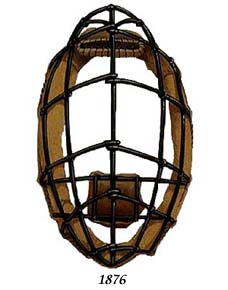 |
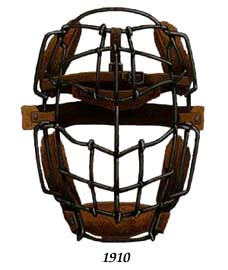 |
Thayer's patented mask went into the Spalding catalog for the 1878 season and adaptations followed quickly. Its simple forehead- and chin-rests were embellished with padding–made from "imported dog skin" according to one Spalding catalog–to insulate the steel-mesh frame from the catcher's face.
Better visibility was always a goal in catcher's masks. Wire-basket cages worn by players like Roger Bresnahan gave way to the greatly improved peripheral vision of so-called "Open Vision" and "Wide Sight" masks by the 1911 season.
The "platform mask"–a one-piece aluminum casting with horizontal crossbars instead of soldered mesh– was patented by umpire James E. Johnstone in 1921. Mesh still evolved, though, getting springy, shock-absorbing action and ball-deflecting shapes in the 1920s.
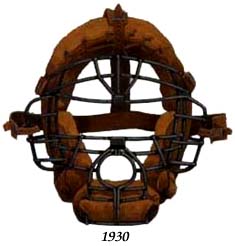 |
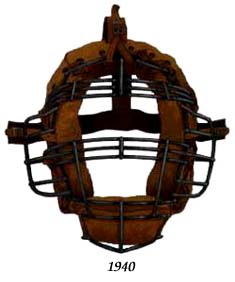 |
Other mask materials have come along, but carbon-steel wire mesh remains the material of choice to this day, according to Ken Nimmons, president of Schutt Manufacturing Co., a leading maker of protective headgear.
"Catchers prefer the welded-wire guard because it has better air movement, and fewer massive bars that could obstruct visibility," says Nimmons. "We use carbon-steel wire because it's flexible but strong. You want some deformation in the mesh to take some of the shock."
Earl Battey, meanwhile, notes that a change in pitching and catching styles is the reason why today's catchers are wearing masks with throat protectors, popularized by Dodger catcher Steve Yeager in the 1970s but available even in 1903.
 |
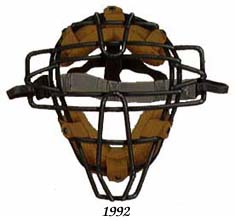 |
We had masks with a little piece that came off the chin, but I did not use it when I played because it was not an issue, he says. With two-handed catching your hands followed the ball into your body. In the process, you were tucking in your chin so your throat wasn't exposed. Catchers today one-hand the ball farther away from their bodies and they're frequently looking up, so the throat's more exposed. The latest-version mask has the throat protector integral with the wire face cage.
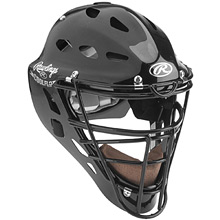
The end of the 20th Century has
seen the mask evolve into something resembling what Darth Vader or Jason would wear. It's genesis sprung
from hockey's goalie mask and introduced by Catcher Charlie O'Brien on May 13, 1997 (Friday the 13th). It is made of new
hi-tech polycarbons and O'Brien's mask was designed by Jerry Van Valden of Toronto-based Catch You Later
Headgear. The helmet protects the top, sides and back of the head, yet the cage-like opening in the front is bigger
than a normal mask. It increases a catcher's peripheral vision and deflects the ball rather than hitting the catcher
flush as does the current mask. At 50 ounces, the helmet is about 10 ounces heavier than a normal mask/helmet combination.
Several major league catchers have begun wearing it and soon it may be a regular piece of equipment.
